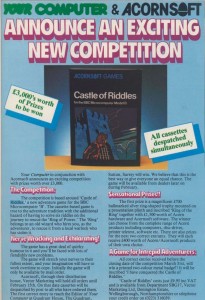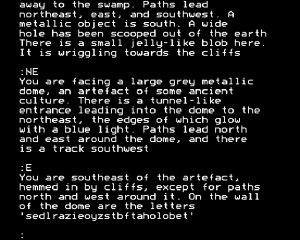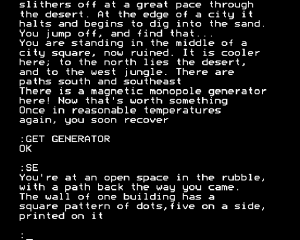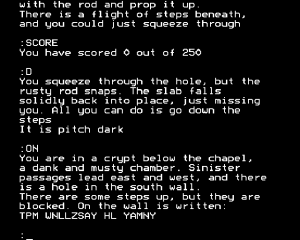Peter Killworth always found time for a wide array of hobbies and activities, ranging from anthropology to stage magic, to supplement his significant career in oceanographic research, but one suspects that he must have been even busier than usual during 1983. Inspired by the unexpected success of Philosopher’s Quest, he published two original games that year with Acornsoft, and ported a third to the BBC Micro for them.
The two originals were Castle of Riddles and Countdown to Doom. The former feels very much like Philosopher’s Quest II, although it is a completely original effort and not, as is sometimes reported, derived à la Zork II and III from yet-unused sections of Philosopher’s Quest‘s mainframe source, Brand X. The plot, such as it is, casts you as a down-on-your-luck adventurer who is hired by a wizard to recover a certain Ring of Power (where have we heard of that before?) from an evil warlock with a penchant for riddle games. Acornsoft had a good reason to want Castle of Riddles to be particularly difficult even by the rather heartless standards of the time: they made solving it into a national contest. Working in conjunction with Your Computer magazine, the company collected orders during the first weeks of 1983, then shipped out copies to all would-be participants on February 15. First to solve it would get a voucher good for £1500 worth of Acorn hardware and software of his choice, along with a magnificently nerdy “£700 hallmarked silver ring-shaped trophy mounted on a presentation plinth and inscribed ‘King of the Ring.'”
When several weeks went by without a winner, there was some concern that Killworth had made the game too difficult, that no one would manage to solve it before the contest’s expiry date of March 31. Thus a 34-year-old businessman named Colin Bignell thought he had an excellent chance when he finished the game at last late one night in March. He immediately dashed to his car and drove through the dawn from his home in Littlehampton, Sussex, to Your Computer‘s offices in London to deliver the code word that the game reveals upon completion. But alas, as he pulled up outside one Peter Voke was already inside doing the same thing; Bignell had to settle for runner-up status.
The Castle of Riddles contest was something of a landmark. Many other publishers would launch similar efforts in the years to come. It proved to be an excellent way to build buzz around a new title in the British software industry, which much more than the American thrived on just this kind of hype and excitement. Perhaps less fortunate was the effect it had on the designs involved. They simply had to be damnably, absurdly difficult to prevent a stampede of players beating down the publishers’ doors hours after release. Thus what could already be a stubbornly intractable genre had some of its worst tendencies elevated to the realm of virtual necessity. Indeed, Castle of Riddles itself is the least of Killworth’s games. Even he regarded it with little fondness; it’s the only one of his Acornsoft games that he did not choose to revive for the company with which he later became associated, Topologika.
Much more impressive, and a significant step forward for Killworth as a designer, is Countdown to Doom, a science-fiction scenario. Your spaceship has just crash-landed on the planet of Doomawangara. You have all of about 215 turns to repair your ship — accomplished by gathering the spare parts that are conveniently lying about the planet and dropping them into the ship’s hold — and escape, after which the ship “collapses” for reasons that aren’t entirely clear (beyond the wish for an in-game turn limit, that is). As that tight turn limit suggests, Doom is an extremely difficult game laced with the usual sudden, blameless player deaths that are such a staple of the Cambridge approach to adventure games. This game, like its stablemates, sends the dial smashing right through the top of the Zarfian Cruelty Scale and just keeps on going. With only 215 turns to hand, getting everything done makes for quite an exercise in planning even once you know the solution to each individual puzzle. Yet its puzzles, while hard as nails, mostly stay just on the right side of fairness, only dipping a toe or two occasionally over the line. They reward intellectual leaps as much or more than dogged persistence (not that the latter isn’t required as well). Let me give a quick example of how heartless yet kind of magical these puzzles are.
In your initial explorations you come upon a bunch of gibberish written on a wall.
Anyone who’s ever played an adventure game can guess that this must be an encoded message, but how to crack it? Well, later in the game you come upon another strange message on a wall.
This is all the information the game provides for cracking the code. Want to have a go at it? Go ahead; I’ll wait…
So, the solution is to take every fifth letter after the first, cycling around and around until every letter is used. This yields “Say ‘flezz’ to disable the robot.” Sure enough, there’s an annoying little thief of a robot elsewhere in the game.
Even if you cracked the code, don’t feel too smug; you had an advantage. In the actual game there is nothing to connect these two messages together, nothing to indicate the second provides the key for the first. I needed a nudge to make that connection myself when I played, but thereafter doing the rest myself was so satisfying that I kind of love the game for it.
Countdown to Doom is easier to love than many games of the Cambridge tradition. For all its cruelty, it does display some hints of mercy. You’re expected to gather six needed spare parts to solve the most pressing problem, that of escape, but a full score also requires satisfying your greedy inner adventurer by gathering six treasures. These, which are generally the more challenging to collect, are actually optional; it’s possible to escape and thus ostensibly win the game (apart from a chiding message telling you you could have done even better) without collecting a single one. This choice adds a welcome dose of positive reinforcement. It’s more satisfying to win the game with a less-than-optimal score and then go back in to improve it than it is to simply fail over and over.
In contrast to Castle of Riddles, Countdown to Doom remained always one of Killworth’s favorite children. Its design is tight and perfect in its own uncompromising way, its puzzles often brilliant. Games from this tradition will always be a minority taste even amongst the minority that can still stomach old-school text adventures in this day and age, but Countdown to Doom is just about as perfect an exemplar as you’ll find of said tradition.
Killworth’s final effort for 1983 was another minor landmark. Kingdom of Hamil was a loving port of the Phoenix game Hamil, the first to be solely authored by Phoenix stalwart Jonathan Partington, to the BBC Micro. Thus it became the first Phoenix game not authored by Killworth to make it into homes, and the first to retain its original title and to remain basically complete in its new form. The story, embellished a bit over the original on the Acornsoft box copy, has you the displaced heir to the throne of Hamil, needing to prove your worth to prove your identity. This being an old-school adventure game, “worth” is meant literally here: you must collect valuable treasures and drop them in the castle vault. As usual, none of this makes a whole lot of sense. No one would ever accuse the Phoenix games of even storybook realism.
But then you don’t play these games for their stories, and Hamil has some wonderful elements. Partington always had a certain fondness for large-scale, dynamic puzzles that often span multiple rooms while requiring precise timing, the sort of thing that demands to be worked out carefully with pen and paper. His talents are much in evidence here. There’s a chase scene with a dinosaur that spans more than 30 turns yet has to be planned and executed perfectly down to the last move, and a similar sequence in which the terrain literally explodes behind you. Much of Hamil is so fun to solve that you can almost forgive it its few puzzles that cross the line. The last of these, however, does a good job of crushing any spirit of generosity you might still have. It’s one of the classic what-the-fuck moments in adventure gaming, reading like a caricature of the brainy, mathematical Phoenix tradition.
Early in Hamil, you find yet another encoded message on a wall.
This is actually easier than the similar puzzle in Countdown to Doom. When a certain locked door starts asking you for a password, it’s not too difficult to figure out that it must be a simple transcription cypher, with the first three words representing “The password is…” By the time you get to the climax of the game, then, you feel pretty confident in deciphering the messages that appear.

Cracking the code yields:
WHAT ARE THEIR ORDERS?
WHAT WAS THE PHRASE?
WHAT IS THE SET, SORTED?
But your difficulties are only beginning. I’ve actually now given you everything the game does, so have at it if you like.
Ready to continue? Okay! In the words of the anonymous writer of a walkthrough from long ago:
You must obtain the set of letters from THE PASSWORD IS, which is THEPASWORDI. Then you must sort the letters, resulting in ADEHIOPRSTW. Finally you must encode this string. You do this in the opposite way in which you decoded messages. Thus, if, for example TPM was decoded to THE, THE is encoded as TPM. ADEHIOPRSTW encodes to NYMPHSWALTZ. To finish the game you must type NYMPHS WALTZ. (SAY NYMPHS WALTZ or NYMPHSWALTZ do not work.)
Really, what could be more clear? Again, solving this here and now, while ridiculously difficult, is actually much easier than it would be for someone encountering it in the game. There you are given no more indication than what you see of what “the phrase” is referring to amongst a big game full of phrases (it’s a text adventure, after all). Thus we come to the hate in my love-hate relationship with Phoenix.
But you don’t have to take my word for it. I’ve prepared a zip file for those of you interested in exploring Killworth’s 1983 for yourselves. It includes each of the three games as a BBC Micro tape image, the way they were first distributed. (To start one of the games on a BBC Micro emulator, mount the tape image, then type *TAPE followed by CH.””. Note also that at least some of the disk images of these games floating around ROM archives and abandonware sites are corrupted and uncompleteable.) I’ve also included some hint sheets, which you’ll likely need. For what it’s worth, when I play I give myself unfettered access to the first level of hints. This usually provides the sort of little nudges that the games so painfully lack, the likes of which Infocom would have provided within the games themselves as a matter of course by this time. I find this lets me appreciate the games’ qualities and enjoy solving them without the whole thing devolving into an exercise in masochism.
Next time we’ll check in with our other special friends in British adventuring, Level 9, to see how 1983 treated them.














